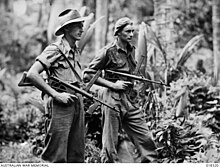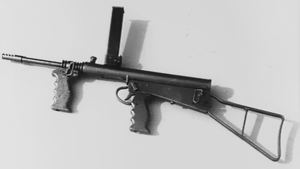Owen submachine gun
| Mpi Owen | |
|---|---|
| general information | |
| Country of operation: | Australia , New Zealand , UK |
| Developer / Manufacturer: | Evelyn Ernest Owen, Lysaghts Newcastle Works |
| Manufacturer country: | Australia |
| Production time: | 1942 to 1944 |
| Model variants: | Mk1 / 42, Mk1 / 43, Mk2 / 43 |
| Weapon Category: | Submachine gun |
| Furnishing | |
| Overall length: | 813 mm |
| Weight: (unloaded) | 4.24, later 3.47 kg |
| Barrel length : | 250 mm |
| Technical specifications | |
| Caliber : | 9 mm parabellum |
| Possible magazine fillings : | 33 cartridges |
| Ammunition supply : | Bar magazine |
| Cadence : | 700 rounds / min |
| Number of trains : | 7th |
| Twist : | right |
| Closure : | Mass closure |
| Charging principle: | Recoil loader |
| Lists on the subject | |
The Owen submachine gun was an Australian infantry weapon. During the Second World War, it was mainly used by the country's armed forces.
history

When tensions in the Pacific region increased more and more in the early 1940s, Australia was forced to adapt the army's equipment to the requirements. The arsenal corresponded to what was available to Great Britain in World War I, modern weapons such as submachine guns were largely absent. Hopes that Britain would supply weapons like the Sten Gun were not fulfilled due to its own tense situation. Ultimately, Australia equipped itself with the development Evelyn Owens, whose designs had previously been rejected as unsuitable.
technology
The Owen-MPi can be clearly recognized by the magazine feed from above. Although it was unusual in appearance and entered service late, the Owen was not an improvised emergency construction. Attaching the magazine to the top should relieve the magazine spring and ensure a reliable supply of ammunition. Stoppages were rare in Owen, including because of the dirt-resistant construction of the castle. In contrast, a visor along the barrel axis was no longer possible, it was moved slightly to the right. The original version Mk1 / 42 weighed almost 5 kg when loaded and was clearly too heavy. Only later was production simplified and the specimens lighter with simplified metal stamping technology. After the war, weapons of the model remained in the arsenal of the Australian Army until the 1960s.
literature
- Günter Wollert, Reiner Lidschun: Infantry weapons yesterday (1918–1945) . In: Illustrated encyclopedia of infantry weapons from around the world . 3. Edition. tape 1 . Brandenburgisches Verlagshaus, Berlin 1998, ISBN 3-89488-036-8 , weapons, p. 86-89 .
Web links
- Maxim Popenker: Owen machine carbine / submachine gun (Australia). In: Modern Firearms. world.guns.ru, accessed on November 3, 2015 .
